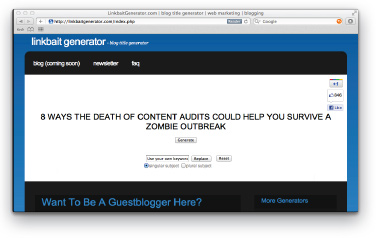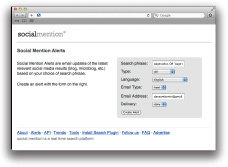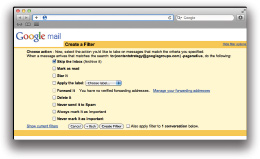This work is licensed under a Creative Commons Attribution 4.0 International License.
*If you prefer a less spiritual analogy, Newton’s third law of motion is equally apt: ‘To every action there is always an equal and opposite reaction.’
You’re going to need a certain amount of faith in these somewhat karmic* marketing methods. Where outbound marketing is highly targeted with directly measurable cause and effect, inbound marketing is more nebulous and embraces customers and non-customers alike, with results that are often difficult to track or quantify.
There are essentially four activities in the inbound marketing cycle, which fall under the overarching principle of ‘getting found’:
A number of factors are at work here. You create and encourage links to your web app, which are vital for prominent search engine rankings. Additionally, each link becomes a mini advert for potential customers who are browsing websites related to your industry. Your supportive behaviour and evident expertise are also perceived as a direct reflection of the quality of your app.
Creating remarkable content is labour-intensive but practically free. This makes inbound marketing particularly suitable for web start-ups, which tend to have more time than money.
In order to publish compelling content that can occasionally deal with contentious issues or tenuously related topics, it’s best to create an explicit blog section on your marketing website that’s separate from your formal app news.
Set up the blog so that it gives you stable incoming links to your app domain over the long term.
Text-based blog posts are practical to create and have predictable SEO benefits, but consider other content formats if you have the tools and expertise, such as video, audio, interactive tools, document templates or downloadable resources.
For the purposes of inbound marketing, your content needs to be more than popular and widely read, it must also be shared through social media and linked to from other websites. To discover what makes great content shareable, let’s look at the motivations for sharing, as researched in a 2010 study by AOL/Nielsen3 and a 2011 study by The New York Times4.
The reports highlight two incentives for sharing: to grow relationships, and to influence the perception of one’s image. Perhaps there’s an element of the handicap principle5 at work, where we create an impression of superior expertise by freely giving away (sharing) knowledge with others.
The AOL study finds that people share content that they trust and that they presume will help others; after all, sharing unhelpful or untrustworthy content won’t improve your public image or professional network. Expanding on these core qualities, your content should be:
Remember to also optimise your content for target SEO keywords (see chapter 23). Include keyword variations in as many posts as possible, but don’t shoehorn them in at the expense of credibility. Content that looks and smells like spam is less trustworthy and less likely to be shared.
If you need an idea for a blog post, try one of these:

The Linkbait Generator8 is designed to produce clichéd blog titles, but it can be useful for inspiration.
Google and other search engines may prioritise websites that exhibit a more even distribution of incoming links across pages.
Create new content as often as you can, but never post for the sake of it. It’s better to create a smaller collection of consistently remarkable content than a wasteland of hit-and-mostly-miss posts, because Google favours sites with more consistent distributions of incoming links9.

The more frequently you are able to publish great content, the faster you’ll build a repository that attracts a significant amount of traffic from all of those variations in long-tail keywords. As a rule of thumb, more content equals more traffic.
Regularly updated websites are also given a major bump in their rankings when a topic that they cover begins to trend, thanks to a Google feature called Query Deserves Freshness10 (QDF). This enables websites with relatively low authority to appear near the top of search results if they have fresher content for a trending topic than their competitors, for example when a popular new event or book about a topic is released11.
I’m kidding. Following the advice of any self-proclaimed social media expert is the equivalent of reading a ‘how to behave in public’ leaflet written by a sociopath: it’s common sense communicated by someone you really don’t want to imitate. Besides, you shouldn’t really imitate anyone. As the cartoonist Hugh Macleod says12, “the trick to Web 2.0, as in business, is to be UNLIKE everyone else.” *
*Ironically, given this section of the book, the context of the quote is Hugh explaining why he is quitting social media.
Aside from common sense behaviour (be polite, be interesting and don’t aggressively self-promote) and Macleod’s pointer on embracing your individuality, there is one other crucial factor of successful social media usage: how to be productive. To get the best results from social networks you need to focus your limited time on quality conversations and avoid the distractions and occasional squabbles that are all too easy to get sucked into.
In order of priority, invest your social media time with the following groups.
If someone publishes a problem that they have experienced with your app, reply with an apology, explanation – not an excuse – and remedy, even if the issue is caused by user error. If the problem can’t be solved immediately, reply with as much information as you have at hand and an estimated fix time.
Always maintain a professional and supportive tone, no matter how negative the customer’s message. Financial compensation in the form of a refund, part-refund or future discount is recommended for cases where a genuine problem has wasted some of the customer’s time – offer one if in doubt. Every issue is an opportunity to convert a disgruntled customer into a vocal endorser.
“If you make customers unhappy in the physical world, they might each tell 6 friends. If you make customers unhappy on the Internet, they can each tell 6,000 friends with one message […]. If you make them really happy, they can tell 6,000 people about that. You want every customer to become an evangelist for you.” 13 Jeff Bezos, founder and CEO of Amazon.com, 1996
These are often self-qualified prospective customers who are giving you an opportunity to impress them with your responsiveness and knowledge. Even if they aren’t likely to convert, it is professional and courteous to reply to all direct questions.
Make yourself visible and available in all conversations about your app, regardless of whether they are positive, negative or simply mention your app casually.
The sooner you interject yourself into discussions (with a constructive contribution) the better. Keyword monitoring apps can identify relevant conversations before they have the opportunity to spiral out of control. Create a Google Alert14 to monitor the web for your app name. A similar alert can be created for social media using Social Mention15, with the drawback that alerts are only emailed daily. Augment the data with a Twitter saved search16 to discover pertinent tweets sooner.

Configuring a Social Mention alert
Alert services can’t detect private conversations, of course, such as those in members-only LinkedIn and Google groups: you’ll need to find and join relevant groups to be privy to their content. Use Gmail filters to sort through the noise and retain only those group messages that mention your app. If you use Gmail as your primary email client, create a filter that auto-archives group messages that don’t mention your app name. If you don’t use Gmail, create a new Gmail account and join the groups under this email address, then create a filter that forwards only app-related messages to your primary email.

Configuring a Gmail filter to automatically archive messages from a Google group that don’t mention an app name
You’ll also need to engage with:
The last two groups require you to proactively participate rather than react to specific mentions. To build a solid reputation with other members you’ll need to invest time into the communities that you decide to contribute to, so choose carefully.
If you’re new to a group, it’s wise to lurk (read but not post) for a while to get a feel for the etiquette and nomenclature before joining in. For example, it may be OK to share a short image-based parody blog post with the informal, acronym-heavy Reddit17 crowd, but it would not be suitable at all for no-nonsense Hacker News18 readers. Be selective about what you share with whom – don’t blanket-post everything to everyone.
Once you’ve got your writing chops in action, consider submitting a new post to a popular website like A List Apart19 or Smashing Magazine20. If it’s accepted, you’ll be rewarded with a valuable link or two from an author profile page on their domain.
If appropriate for your type of app, create a back-linked graphical badge that your users can copy and paste into their websites. The badge might be a simple display of belonging (I ♥ App Name), an appeal to their ego (I’m an expert on App Name) or campaign-based (I support the App Name campaign for accessible websites). To avoid potential widget bait21 problems with search engines, the badge should look clickable, be relevant to your app and only contain a single link.
Use a tool like Open Site Explorer22 to find authoritative websites that link to your competitors and, if applicable (for example, the page is a list of useful resources), get in touch and politely request a link to your app.
If your users create non-sensitive content in your app, consider making it (or a selection of it) publically accessible, so that your users create unique, indexable content on your behalf. Of course, you’ll need to make sure that your users are aware of any content that you may make public.
Consider licensing your blog posts under a Creative Commons licence23 that requires attribution by backlink. This allows other websites to republish your content if they also include a prominent link to your web app. Your posts shouldn’t face duplicate content issues as long as they are published first and the majority of republications include the attribution link. You should occasionally check for abuses of the licence and follow up accordingly with the publishers.
It takes skill, patience and customer insight to create content and social media conversations that are valuable to your market and, hence, valuable to you.